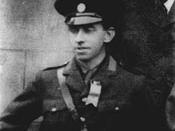The Rebellion
Great poets undeniably have an ability to seize upon particular incidents and use them to explore and illuminate the human condition. In William Butler Yeats Poem, "Easter, 1916" he does just that. This poem commemorates the Easter Rising of 1916, in which a group of Irish insurgents captured the General Post Office in Dublin and held out for several days before surrendering. It also represents the constant turmoil present in Ireland that will not yield until the nation is united. As a result because of its powerful choice of words describing the Easter Rising, Yeate's poem "Easter, 1916" plays a major historical part in Ireland's coming of age.
The Easter Rebellion of 1916 took place in Dublin, Ireland on Easter Monday. The purpose was the withdrawal of Ireland from the United Kingdom and the formation of an Irish Free State. The Irish Republican Brotherhood and the Irish Citizen Army, using German supplied arms, carried out the rebellion.
However, the British intercepted the German weapons shipment before it could reach the rebels. Along with the arrest of Roger Casement, a renowned human rights campaigner and Irish Nationalist, prompted the nationwide rebellion to be called off. Patrick Pearse and James Connolly decided to continue the operation but it was confined to Dublin and only about 1600 rebels participated instead of 16,000. The rebellion was doomed before it even started. The rebels were outnumbered by the British soldiers and they were forced to surrender a few days later, and after that they were executed.
The purpose of the poem is a memorial for the people who gave their lives on Easter Monday. Yeats starts in the first stanza by describing the people or the "vivid faces" (l, 8) he sees every day. At first they are insignificant to him...



Anti-thesis
I have studied the same poem and share many views as yours. Did you however consider Yeats' use of anti-thesis central to what he was trying to convey through the poem?
0 out of 0 people found this comment useful.